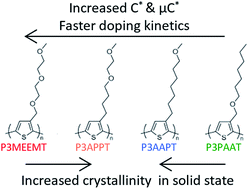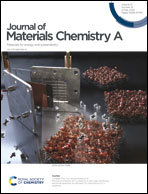Impact of varying side chain structure on organic electrochemical transistor performance: a series of oligoethylene glycol-substituted polythiophenes†
Abstract
The electrochemical doping/dedoping kinetics, and the organic electrochemical transistor (OECT) performance of a series of polythiophene homopolymers with ethylene glycol units in their side chains using both kosmotropic and chaotropic anion solutions were studied. We compare their performance to a reference polymer, the polythiophene derivative with diethylene glycol side chains, poly(3-{[2-(2-methoxyethoxy)ethoxy]methyl}thiophene-2,5-diyl) (P3MEEMT). We find larger OECT material figure of merit, μC*, where μ is the carrier mobility and C* is the volumetric capacitance, and faster doping kinetics with more oxygen atoms on the side chains, and if the oxygen atom is farther from the polythiophene backbone. Replacing the oxygen atom close to the polythiophene backbone with an alkyl unit increases the film π-stacking crystallinity (higher electronic conductivity in the undoped film) but sacrifices the available doping sites (lower volumetric capacitance C* in OECT). We show that this variation in C* is the dominant factor in changing the μC* product for this family of polymers. With more oxygen atoms on the side chain, or with the oxygen atom farther from the polymer backbone, we observe both more passive swelling and higher C*. In addition, we show that, compared to the doping speed, the dedoping speed, as measured via spectroelectrochemistry, is both generally faster and less dependent on ion species or side chain oxygen content. Last, through OECT, electrochemical impedance spectroscopy (EIS) and spectroelectrochemistry measurements, we show that the chaotropic anion PF6− facilitates higher doping levels, faster doping kinetics, and lower doping thresholds compared to the kosmotropic anion Cl−, although the exact differences depend on the polymer side chains. Our results highlight the importance of balancing μ and C* when designing molecular structures for OECT active layers.



 Please wait while we load your content...
Please wait while we load your content...